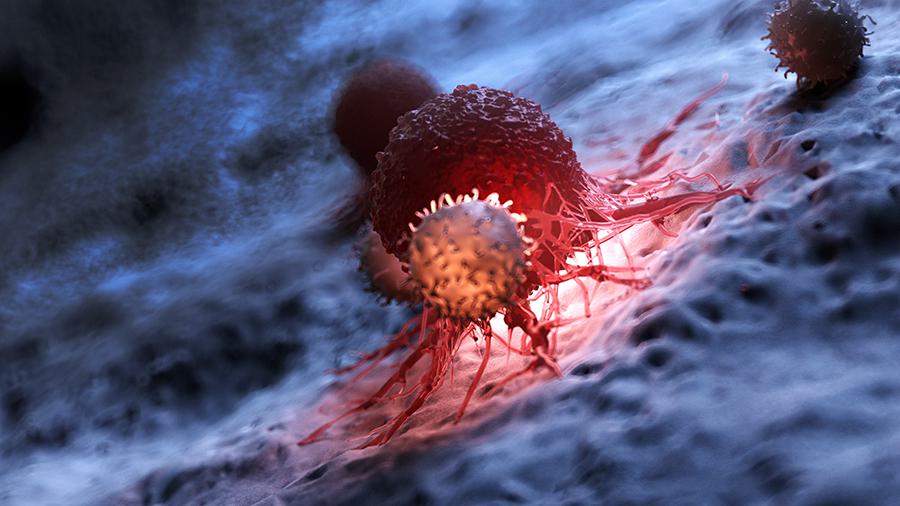T cells spend their lives talking the language of disease, and we should listen to what they have to say.
Almost every cell in the body chews up a small fraction of its proteins and presents them as antigens on its surface to enable immune system monitoring. T cells surveil these antigens and represent the critical first arm of the adaptive immune system. This component of the overall immune system kills diseased cells, coordinates antibody production by B cells, and provides the essential memory of past disease. For every antigen that a T cell probes with its highly variable T cell receptor (TCR), the cell must integrate the resulting signaling with a variety of its past and current experiences. These include the core functional training the T cell received in the thymus, memories of previous antigen exposure, all previous and concurrent immune interactions, and the microenvironment and functional state of the target cell it is probing. In choosing among many potential paths, each T cell, and the T cell compartment as a whole, must find a balance between killing cancer and aberrantly attacking healthy tissue, thereby causing autoimmune disease. T cells must walk that fine line every day, and in doing so they collectively demonstrate a fundamental and severely underappreciated ability to continuously monitor every cell in our body.
The enormous potential and limitations of current T cell therapeutics are best exemplified by two of today’s most vaunted avenues of therapeutic research: checkpoint inhibitors that disinhibit T cells to enable antigen-specific tumor killing, and CAR T cell therapies that redirect a patient’s own T cells to known antigen targets on cancer cells. Both therapeutics leverage T cell potency to kill cancer cells, but they do it with almost no knowledge of the native antigen specificity of the cells, often resulting in toxicity—particularly with checkpoint inhibitors, when the activated T cells turn against healthy tissue to cause autoimmunity.
What we can learn from B cell development
The current state of T cell antigen discovery can be understood by considering its sibling B cells. With B cells, revolutions in antibody screening and protein engineering have allowed antibodies and their derivatives to transform medicine and dominate the biologics market. As with T cell therapeutics today, the first B cell therapeutics were poorly defined mixtures of B cell–produced antibodies targeted to specific antigens. The result was antiserum therapeutics that were initially used as antibacterials (and predated antibiotics by over 40 years) and are still used to great effect today as antivenoms. The turning point came in the 1970s with technologies that allowed high-throughput antibody interrogation. Hybridoma technology and, later, surface display technologies provided high-throughput screening methods to identify individual B cell antibody clones that bind a specific target antigen. This ability to produce, screen, and optimize antibodies resulted in five of the top six biologics on the market today, whose mechanisms include the core targeting moieties of both the checkpoint inhibitors and CAR T therapeutics.
T cells should be our teachers
T cells should follow a similar path to antigen discovery and therapeutic value, but there are critical differences in T cell biology that will increase both the difficulty of antigen discovery and the potential value of the antigens and therapeutic modalities that result. T cells function through direct cell-cell interactions in which they use their highly diverse T cell receptors (TCRs) to inspect antigens loaded on a target cell’s surface. Upon interaction with their target antigen, activated T cells often stay at the target site, rapidly expand, and kill the target cell. This makes T cells a potent weapon against infections and diseases such as cancer. But it also makes them ideal immune teachers, because their presence can be used not only to isolate the TCRs that bind to diseased cells but also to identify antigens that protect against infectious disease, cancer, and autoimmune disease. Perhaps most important, these antigens are derived from proteins in all cellular compartments, including the cytoplasm and organelles, providing a much larger range of disease-specific targets than are possible for B cell antibodies, which target only surface and secreted molecules.
What we need is a method to decipher the functional state of T cells, the TCRs they carry, and the immunogenic antigens that they see.

T cells see color, not black and white
Many of the antigens that T cells see in these diseases are not the ones that immunologists typically look for. Antigens generated by pathogens and cancer mutations have never been produced by the body or encountered by the body’s T cell repertoire, so they are typically described as foreign, or non-self. Cells that display these non-self antigens are recognized by T cells and killed. Then again, a core tenet of T cell biology is that all T cells that react to self are killed or converted to regulatory T cells; self-reactive cells that escape this clearance and central and peripheral tolerance cause autoimmunity. And yet time and again self-reactive T cells are found in tumors. Early examples were identified from testes and other immune-privileged sites where cells and their presented antigens are shielded from T cell surveillance. Proteins from immune-privileged sites that are aberrantly expressed in cancer cells can be immunogenic, and these cancer testes antigens, such as NY-ESO-1 and MAGE-A1, are the foundation of many of today’s targeted T cell therapy trials.







